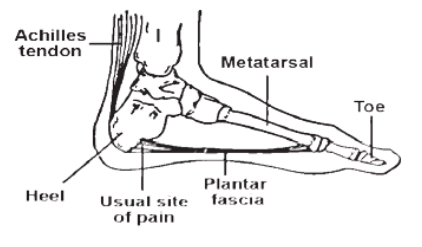Plantar fasciitis
This page provides you with information about plantar fasciitis and exercises that can help reduce your pain.
What is the plantar fascia?
The plantar fascia is a band of thick tissue that runs along the bottom of your foot. It runs from your heel almost to the base of your toes. It is an important structure as it helps lift the arch of your foot during walking and supports your foot.
The plantar fascia also acts as a shock absorber when you walk.
What is plantar fasciitis?
Plantar fasciitis is a common condition. It results in pain around the inside of the heel and foot. The pain is often worse first thing in the morning or after long periods of rest or activity.
The condition is the result of excessive stretching of the plantar fascia which can be caused by:
- Over-use such as too much physical activity; running, walking or standing for a long time particularly if there is a rapid increase in activity over a short period of time
- Obesity
- Ageing
- Shoes without cushions
- Walking barefoot on hard surfaces
- Occupations such as teaching or working in a factory that requires walking or standing for long periods
Heel spurs
A heel spur is a small growth (collection of calcium) on the edge of the heel above where the plantar fascia starts. Many adults have a heel spur and they are not thought to be the cause of plantar fasciitis.
Management of plantar fasciitis
Rest - reduces inflammation and gives your foot more time to heal.
Ice - after activity it may help to apply an ice pack to reduce inflammation.
Stretches - please see the exercise section.
Arch support inserts – these are placed inside your shoe.
Weight loss - losing weight can help to improve your posture and the way you walk.
Foot wear - wear a house shoe/trainer at all times. Do not walk bare foot as this stretches the plantar fascia. You should also avoid wearing slippers, slip on shoes, flip flops or backless shoes.
In most cases, inflammation of the plantar fascia will improve, although this can take a long time.
Stretches
The following stretches can relieve the pain caused by plantar fasciitis and help your recovery. It is advised that the stretches are repeated 6 times daily.
- Stand with your feet hip width apart and take a step forward. Take most of your weight on the leading foot. Gradually take your weight to the back foot stretching your heel to the floor. Keep your upper body in line. Hold for 10 seconds and then swap legs, repeat 4 times. To increase the stretch, take the back foot further back each time so that the gap between the feet increases and alters the centre of gravity.
- Stand with the leg to be stretched behind the other leg. Push your heel down while bending your knee to stretch the Achilles tendon. Hold for 10 seconds and then swap legs and repeat 4 times.
Footwear
Ill-fitting or worn shoes do not support your foot and may lead to increased strain on the plantar fascia. Worn shoes also lose the ability to act as shock absorbers. Always make sure that your shoes fit you correctly. Podiatry will be able to advise you on the style of shoe best suited for your feet.
If your pain does not improve after following this advice for 3 to 4 weeks you may wish to self-refer to the Gloucestershire Podiatry Service, please see the contact details below.
Contact information
Gloucestershire Podiatry Service
For a copy of a referral form:
Tel: 0300 421 8800
Email: podiatry.appointments@ghc.nhs.uk
Website: www.ghc.nhs.uk/self-refer/podiatry-self-referral-form/

